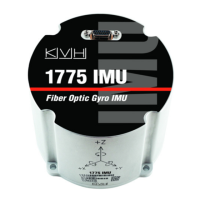This document contains proprietary information of KVH Industries, Inc. and neither this document nor said proprietary information shall be
published, reproduced, copied, disclosed, or used for any purpose without the express written permission of a duly authorized KVH
representative.
The interpolated value is then further processed to do some of the following:
If Uniform Averager is active, then the interpolated value is divided by the number of
internal samples it contains.
Any limits to rate (or acceleration) are checked and enforced and the validity status is
updated as needed. This is required by the calibration range. Unit conversion is applied
as configured. This changes rate (or acceleration) to delta-angle (or delta-velocity) and
also the configured rotation units (radians or degrees) or linear units (meters or feet).
The output process then goes on to combine the various data as needed by the output
format into the final output message. This would include the appropriate header word, status
values, temperatures, CRC word, etc.
12.2.6 Additional Information: Output Rate Resampling
In the 1775 IMU family, the rate of the output of data to the user is configurable in a number
of ways. It is, however, asynchronous to the internal sampling rate of both the gyro and the
accelerometer sub-systems and it occurs at a lower data rate. Therefore, there is a need to
do the following:
1) resample the internal discrete data points at a slower and arbitrary rate
2) limit latency to preserve real-time response used for stabilization applications
Ideally, sample rate conversion should be done at integer multiples, up or down, of the input
sampling rate. Then some simple integer interpolation-upsampling and/or decimation-
downsampling can achieve the sample rate conversion. If the output to input rates can be
related by ratios of integers, then both interpolation-upsampling followed by decimation-
downsampling can be applied.
Generally, in a system where the input and output rates are not direct integer multiples or
integer-ratio related (i.e., they are asynchronous and, by some definitions, arbitrary) there are
some non-realtime or near-realtime algorithms that can be used. For systems that can
tolerate some latency (e.g., music sampling conversion or imaging), these include use of
processing buffers to achieve low sample jitter rates, highly complex FIR filtering to minimize
phase distortion and other techniques that are compatible with non- or near-real-time
systems.
Some Optional References About Asynchronous Resampling Include:
1) http://www.iet.ntnu.no/courses/fe8114/slides/upsanddownsofasrc.pdf
2) http://www.analog.com/media/en/technical-documentation/technical-
articles/5148255032673409856AES2005_ASRC.pdf

